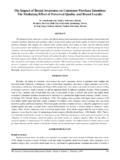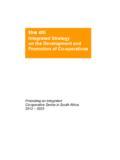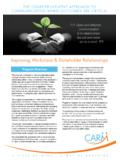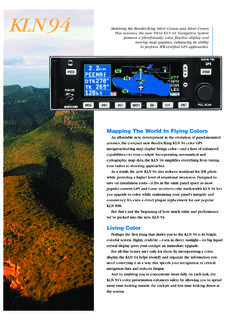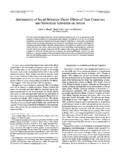Transcription of How Mindfulness and Situational Awareness …
1 Benefits magazine march 201630 How Mindfulness and Situational Awareness Training Help Workersby | Raquelle Solon and Randall KratzReproduced with permission from Benefits Magazine, Volume 53, No. 3, March 2016, pages 30-33, published by the International Foundation of Employee Benefit Plans ( ), Brookfield, Wis. All rights reserved. Statements or opinions expressed in this article are those of the author and do not necessarily represent the views or positions of the International Foundation, its officers, directors or staff. No further transmission or electronic distribution of this material is permitted. MAGAZINEpdf/216march 2016 benefits magazine31 Mindfulness and Situational Awareness may seem like industry buzzwords, but they re words to which a benefits planner may want to pay attention.
2 These concepts can be understood in two key ways for workforces of all is a state of active, open attention on the present. It s more than yoga and meditation; it s being aware of one s own internal health and wellness something ben-efits planners put a lot of time and energy into fostering among their healthy employee has a healthy mind as well as a healthy body. Mindfulness describes a comprehensive, integrated ap-proach toward improving health and productivity in work environments. It allows employers to help employees become more aware of their overall health status and risk factors and provide them with tools, resources and coaching to take con-trol of their lives and make healthy changes and used proactively with other wellness and benefits tactics, Mindfulness can boost employee resiliency and re-duce the prevalence of gaps caused by Awareness is an external application of that same Mindfulness .
3 It s the ability to frame one s mind to know what is going on in workplace surroundings, to iden-tify any deviations from the norm or standard processes, and to address unsafe conditions, environments and potential risks before they become military and security-related fields for decades have focused on this type of Mindfulness about the work environ-ment. Today, it s becoming more and more important for ex-perts in occupational health and safety, department leader-ship and human resources, including benefits who are mindful of their own health and well-ness also tend to have better Situational Awareness .
4 They re more apt to silently influence co-workers to be mindful in ways large and small. The co-worker who carries her step-counting smartphone app with her each time she leaves her desk, for example, eventually may get other co-workers thinking about how many steps they take. The more mindful a workforce is, the more resilient its members will be to an adverse situation at a personal or companywide Role of the Benefits ManagerAs organizations realize the connections among mental health, positive workplace relationships, culture and produc-tivity, they more often are promoting benefits and programs that allow employees not only to seek help but also to iden-tify stress and adverse lifestyle behaviors before the negative consequences spill over into the managers in charge of analyzing.
5 Designing and administering programs are in an important position to offer company leadership the Mindfulness and Situational aware-ness tools they need to identify trends related to department issues and workplace-related stress. Many factors that contribute to a dwindling bottom line high attrition rates, absenteeism, disability claims and lost productivity, to name a few can be improved by offer-ing Situational Awareness and Mindfulness programs as part of a company s benefits the larger scale impact of robust benefit plans as well. Rarely does a day go by without disturbing news that impacts the collective workplace domestic violence, data breaches and identity theft, school and workplace shootings, and city and campus Laurie Anne Spagnola, president and CEO of the Board of Child Care of the United Methodist Church in Baltimore, Maryland, the civil unrest in 2015 caused a major disruption for her workforce.
6 Certain key commuter arteries in the city were closed, preventing some employees from getting to work. Through the Alliance for Strong Families and Communities, Spagnola was put in touch with a crisis counselor. The next day, a counselor with experience with crisis situations was at the Board of Child Care Baltimore campus talking with employees. That meant a lot to our 450 employees, knowing that we were taking care of them, said Spagnola. Their Situational Awareness was heightened, and the crisis counselor helped provide calm inside while the unrest continued outside. Benefits That Improve MindfulnessSeveral products in the overall benefit package can help with Mindfulness .
7 Three useful benefits to consider, if an or-ganization doesn t already offer them, are:Benefits such as Mindfulness training can result in happier, mentally healthier employees, while Situational Awareness training can help employees identify risks to safety and the work magazine march 201632 An employee assistance program (EAP). An EAP that is compre-hensive enough to include support on everything from stress manage-ment to life transitions counseling to family care options provides quick, reliable guidance so em-ployees can come to work with greater peace of mind. Even better is a program that also covers alco-hol and other drug abuse treat-ment counseling, domestic issues and crisis counseling.
8 A robust EAP can have a significant impact on employees productivity and at-titude. Resilience training. Programs that incorporate resilience training help improve the quality of life and stress level of the employee. They foster the ability to adapt and re-cover quickly after stress, adversity, trauma or tragedy. Employees with a resilient disposition are better able to maintain a healthy level of physical and psychological well-ness in the face of a challenge. Bullying policies. Humiliating, intimidating or verbally abusing a co-worker is a form of psycho-logical violence in the workplace. Companies that address bullying through training and/or written policies set expectations for a re-spectful to Help Increase Situational AwarenessBenefits managers can partner with an organization s security or training department to offer ongoing programs and training sessions to help raise situ-ational Awareness levels among staff.
9 These programs include: Crisis preparation, training and drills. Forward-looking compa-nies that develop crisis plans, of-fer crisis training and conduct crisis drills are one step closer to creating a resilient workforce. Deescalating violence training. Managers, including those in hu-man resources, may benefit from training to help deescalate anger and violent behavior. National programs like the Mandt System provide hands-on training for managers and staff. Trauma-informed care/adverse childhood experience (ACE) training. Studies show that 66% of the general population is affected by ACEs. These experiences may present undesirable effects on now-adult lives.
10 It s wise to be aware of employees actions while at work if they mark a significant contrast to their normal behavior. Training can help foster better un-derstanding, as well as thoughtful and appropriate Power of TrainingTraining is the next step in situ-ational Awareness for not only execu-tive leadership and management but also employees. Increased Awareness of difficult situations and workplace risk, coupled with effective training on how to respond, has been proved to reduce workplace violence , management and leadership aren t aware of low-level violent behav-mindfulnesstakeaways Mindfulness training can boost employee resiliency and reduce workplace absenteeism.



